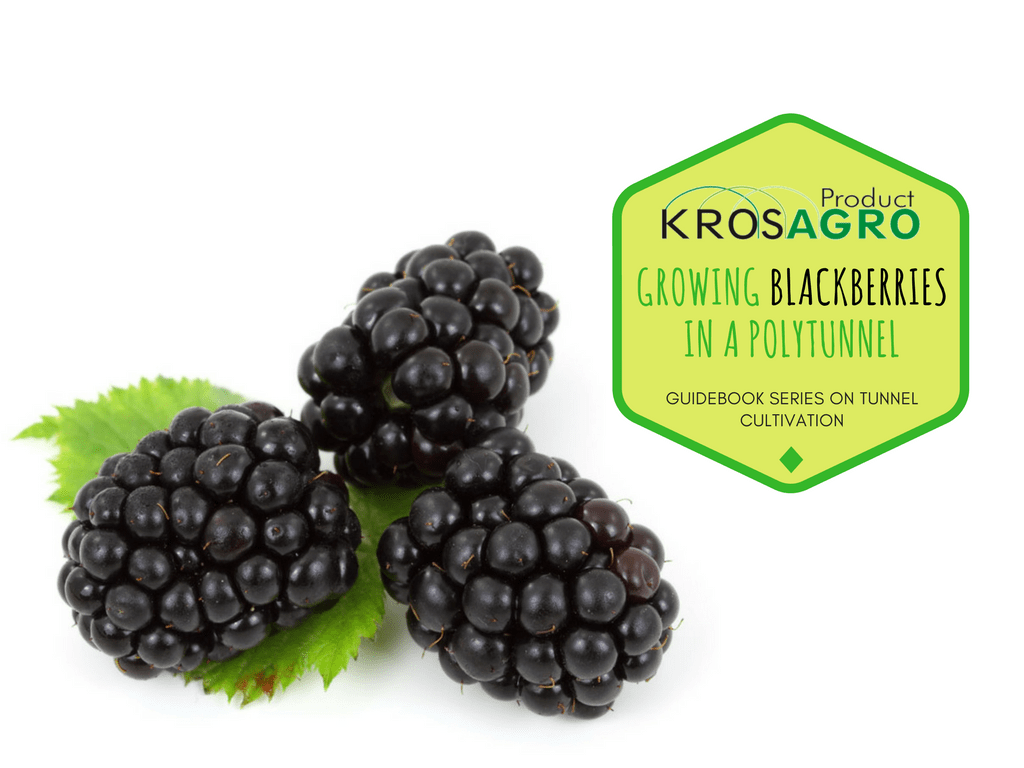In this part of the
Krosagro guide, we will explain how to start growing blackberries in a
polytunnel step by step: how to prune, cultivate, when to plant, how to protect from frost and when to harvest them. In order to prevent any damage, however, it is best to choose a thornless variety.
What is a blackberry?
This edible plant from the rosaceae family is a variety created from wild blackberry and several others. Its special feature is that spikes have been removed at the stage of crossing. Making the whole breeding process more convenient.
Blackberries have little cultivation requirements. Which is why it is the most frequently chosen bush for a home garden or plot. They blossoms in May with white flowers, attracting pollinating insects. Sweet-sour or tart flavor of the fruit makes them suitable for the production of tinctures, preserves and wines. First fruits appear in July, however the real harvest begins at the turn of August and September. The fruits collected then are the sweetest.
Stems may reach 2 to 5 meters, with time they will require help, meaning preparation of supports. These should be fixed to the structure as plants do not have any climbing features. Due to the size of crops, seasonal foil tunnels will be more suitable. As they are much higher than single or multi-vegetation greenhouses. Of course, you can also use these hobby tunnels, but you will have to trim bushes so that they do not come into contact with the cover.
1. Cultivation requirements for growing blackberries
Although the plant itself is not difficult to grow, it has specific environmental requirements. It should not be grown in an area where
tomatoes, potatoes, peppers, raspberries and strawberries. Were cultivated in the previous three years. Many diseases and pests that attack these plants are also a threat to blackberries.
Bushes grow optimally in a warm and sunny location. They also grow in shady places, but then fruiting is not the best. The plant has a medium frost resistance, so it should be covered during the winter.
The substrate should be rich in macro- and micro-components, rich in humus, light and moderately moist, slightly acidic and pH between 6.0 and 7.0. At less than 5.5, the substrate will have to be limed, and at higher levels, blackberries may develop iron deficiencies. Sandy and heavy substrates are not suitable for their cultivation. However, with no other choice, it will be necessary to fertilize with manure, compost or green manure.
The plant requires slightly acidic soil for proper growth, therefore fertilizers with high concentration of potassium and nitrogen are used. In spring, the plant is supplied with multicomponent fertilizers, 50 g of ammonium nitrate and up to 50 g of potassium sulphate for each bush separately. Blackberry is a perennial plant (it lives up to 20 years), so it is worth providing a regular dose of compost every year.
2. Planting and spacing
The beginning of spring or late autumn is a good date to plant blackberries. The base for the plant should have a depth and width of 45 cm. Because at the time of planting, you need to mix soil with manure. Then cover the roots with soil, pat down with your hands and generously water. The distance between each plant should be between 2 and 4 m. Remember to build a climbing frame to support them.
Blackberry propagation is quite simple, just take emerging stems or prepare seedlings from horizontal shoots. It is worth remembering that blackberry is hard to manage and you can end up with shoots emerging from the ground with spikes. This, however, significantly hinders later care.
Blackberry develops fruits on last year’s shoots, so these should be pruned at ground level. Young shoots are left until spring, and only leave the strong and healthy ones after winter. Their number depends on the variety, its growth and conditions during development, but usually varies from 6 to 8. Weak or sick shoots should be cut so that they do not overload the plant. The rest spreads over the structure in order to get sun exposure. The new shoots emerging of the ground near the main. Plant should be eliminated, torn off or cut with a spade.
Mulching with agrotextile in a polytunnel – blackberry bushes can not tolerate prolonged drought due to their shallow root system. To prevent soil from drying out and minimizing weed infestation. Agrotextile can be laid on the entire crop in the greenhouse. In order to avoid damage caused by frost, shrubs before winter are covered with non-woven fabric or straw mulch. Of course, a greenhouse or a mini foil tunnel offer enough protection.
The plant produces for three months, in July, August and September. It is worth checking the greenhouse from time to time to systematically collect fruits. Usually 3 to 8 days after the appearance of ripe fruit on the bush, the next ones are ready to be cut. It is very important not to pull the blackberries, as it easily crumbles when picked from the stalks. The safest way is to cut them off. In order to extend storage time, harvest should be carried out on a dry day or after ventilating the greenhouse. Dry fruits are characterized by a longer shelf life.
Conclusion
Until recently, blackberries have been associated by many people with the forest only, because that’s where these tasty fruits could be collect. With time, varieties were created to suit cultivation in the garden or a polytunnel. A lot of medicinal properties, a wealth of mineral salts, large amounts of vitamins C and E are enough reasons to find a place for growing blackberries in the plot or under cover.
https://www.youtube.com/watch?v=9ei9C4dFD6w&ab_channel=KrosagroPolytunnels
